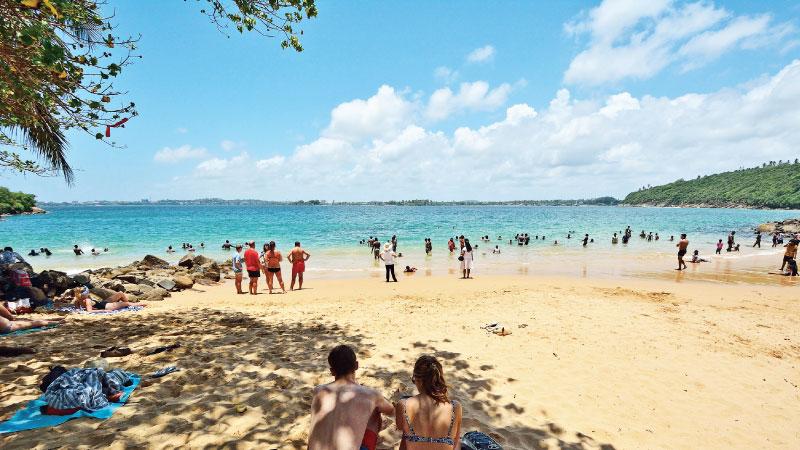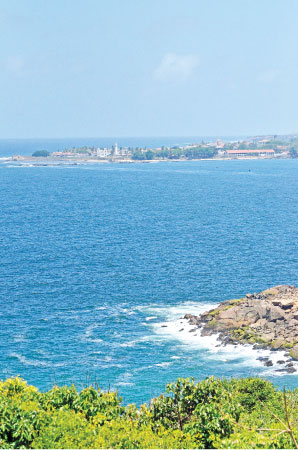
“I say that a myth is a story, which has a particular energy – mythic resonance. I always say that a myth is a tear in the fabric of reality, through which all of this spiritual energy pours”
Jay Parini (1948 - )
- American Writer and Novelist
The cultural profile of humans, is emphatically enriched and enlivened by myths, legends, fairy tales, folk lore and creations of that ilk. Each nation, each country and even each clan and tribe, may have its own store, trove or pool of legends and myths.
We, in Sri Lanka, though inhabiting a tiny island citadel, possess a stupendous hoard of treasured legends and myths, that stem from a vast variety of sources. Many are spiritual, religious and cultural in origin. Some are associated with folk life.
 But, of all those, the most far reaching and perpetually challenging legend, we have inherited, is, of course, that of Rumassala, popularly linked with the great Indian Epic “Ramayana” attributed to sage Valmiki.
But, of all those, the most far reaching and perpetually challenging legend, we have inherited, is, of course, that of Rumassala, popularly linked with the great Indian Epic “Ramayana” attributed to sage Valmiki.
Rumassala dates back to a hoary past, that pre-dates our formal history, by several ages.
Surprisingly substantiating my claim that Rumassala is a “Once and future myth”, India released a news item, just a couple of days ago. According to this, “The Indian Railway will launch a special tourist train from Ayodhya to Colombo, on the ‘Ramayana Circuit’, covering the locations associated with the Hindu Epic”. I would be particularly happy, if the tour planners could include Rumassala, in Unawatuna, in their Sri Lanka Leg of the tour, as this site is profoundly intertwined with the Rama Tale.
It must be quite clearly recognised, that a legend or myth is not necessarily formal or authentic history. Nevertheless, a legend may, at times derive from a stray trace of history. Over the ages, mount Rumassala at Unawatuna, has proved to be the primary core and focal point, around which a vast array of myths and legends have steadily accumulated.
The Rumassala escarpment, has as its base, a rocky formation, which according to geologists, is about a million years old.
Rumassala Escarpment stretches eastwards, from Dewata Beach (about 2 miles to the South of Galle) to taper off at Yaddehimulla, where the Wella-Devala shrine stands, at the end of the promontory. Over the centuries, a lush green forest grew, providing an alluring cover, to the mass of rock, at the base. The abruptly rising mount seems an uncharacteristic geological formation, when compared with the undulating plain surrounding it. This gave rise to the speculation, that the mount of Rumassala, was a feature, ‘introduced’ from outside.
Fragment from the sun
A recent writer, decided that this was a ‘fragment’, that fell from the sun. Fragments do not fall on planets from the sun. What is quite likely is, this is an asteroid or a piece of comet – material, that came from the Oort cloud, at the edge of the solar system. The Oort cloud consists of planetary debris. Occasionally, a stray object may get dislodged from the Oort cloud, pulled by solar gravitation. Such a fragment is quite likely to have fallen on earth, forming the mount.
But, the ancient mass mind discovered a legendary explanation, to solve the mystery of Mount Rumassala. They adapted an episode from the Epic Ramayana, to unravel the mystery of the origin of Rumassala.
We will look at this legend briefly. In the course of the battle between the forces of Rama of India and those of Ravana of Lanka, an enemy arrow wounded Prince Luxman – Prince Rama’s brother. The chief physician of Rama’s Army, examined the wounded Prince and made a pronouncement. “I can restore Luxman to complete health, if four herbs are brought swiftly from the Himalayayas”, Hanuman the monkey god undertook the urgent mission. When he reached the Himalayas, Hanuman’s memory left him. He could not recollect the names of the prescribed herbs. He broke off the segment of the Himalayas, where the herbs grew. He presented the Himalayan fragment to the chief physician. After the chief physician extracted the essential herbs, Hanuman threw away the Himalayan chunk.
And, this Himalayan fragment fell to earth at Unawatuna, forming the legendary Rumassala.
In order to add further weight to this legendary origin, mass wisdom created a popular etymological meaning to the village name Unawatuna. They said it is derived from ‘Onna Vatuna’ (there, it fell). ‘Onna Vatuna’, according to that interpretation, ended up as Unawatuna. This, far-fetched folk etymology, is entirely wrong. In reality “Unawatuna” implies “Oona pattana” (The Minor Harbour). It was Unapatuna at first. Later it turned into the current Unawatuna. I am quite keen to put this right, especially, because, Unawatuna is the village of my birth.
Some tend to believe that Rumassala signifies “the Beautiful Hill” (Rumath Sala). There is a foreign name to this hill - “Buona Vista” endowed either by the Portuguese or the Dutch, I believe. It can be interpreted as the Beautiful View.
There is yet another far out, interpretation. According to that, the name implies “Rama-issu-gala”. To establish this view, he says, Ravana had confined Sita to a cave.
The entrance had been blocked with a heavy slab of stone. Rama lifted the stone-slab and freed Sita. Henceforth, the place was known as “The Location where Rama lifted the stone-slab” (Rama Issu Gala) – Rumassala. This, seemingly naïve interpretation, totally ignores the crucial spirit of the Epic-Ramayana. Ravana, treated Sita right royally. She was provided an elaborate palace. In such a context to suggest that Sita was confined to a cave, closed with a heavy stone-slab, is not at all acceptable. To my mind, Rumassala is simply “Ramassala” - “The Mount of Rama”. From childhood, I have had the opportunity of listening to an extensive series of “sub-myths”, relating to the legendary “Rumassala”.
I was born in the shadow of Rumassala. To us, in the village of Unawatuna, the Mount of Rama, was a form of natural fornication.
When the disastrous Tsunami, unleashed its fury, our village was saved, as Rumassala proved a protective rampart. The two edges of the Rumassala, escarpment, suffered grievously.
Myths have it, that, the potent medicinal herbs from the Himalayas, that brought Laxman back to life, are still there, growing wild. Four varieties of life-giving herbs are especially referred to.
They are mrta sanjeevani ( the herb that brings the dead back to life), vishalya kavani, uvarnakarani and sandhani are the miraculous healers. Fabulous herb, that possesses the capacity to transform an aged person to youthfulness, called ‘Kalunika’, still exists in Rumassala – according to legend.
The long promontory, at the far edge of the eastern end of Rumassala, is the site of the ancient “Beach Shrine” (Welle Devala).
When we were children, about 80 years ago, we would watch the sea, from this ‘Wella Devala’. From there, we could have the fascinating view of massive waves, breaking into white clouds of spray, on the large boulders.
Myth has it that, a God sailed into this section of the sea, adjacent to the present Wella Devale, on a raft of stone. He settled down at this site, and eventually became the central divinity of a cult. The annual pageant of the devale, dates back to that ancient era, when that God, sailed into the present site of the devale.
To Dr. Arthur C. Clarke, when he visited this site way back in 1956, the sea was the diver’s dream. His keenest hobby was diving. Dr. Arthur C. Clarke let it be known, that the sea at the edge of Rumassala, was perhaps the best site in the world for diving enthusiasts. The explorations of Dr. Arthur C Clarke, added another and unparalleled dimension to the myths and legends associated with Rumassala. Dr. Clarke revealed, that there was a place, in the sea next to Rumassala, that did not come within the magnetic field, that extends over the totality of the planet’s surface.
This “hiatus” could have occurred because some unknown metal or a similar entity was buried deep in that location of the sea. This could have happened millions of years ago. (This is yet another “fall”, relating to this Rumassala region).
Dr. Clarke pointed out, that the communications Satellites, placed in the ‘Clarke Orbit’, 21,300 miles up in space, move along and stay exactly above the magnetic ‘hiatus’, near Rumassala. This happens when their fuel is exhausted. This is yet another Rumassala legend.
Legend of Ravana
According to legend, Ravana, flew in his aircraft known as Pushpaka (popularly identified as the Dandu Monara – the wooden peacock), visiting places in India. Amazingly, it could be stated that this Lankan ruler of myth and legend, is the first man in human history, to operate an Airline. As irony would have it his famous passenger – Sita, was brought along forcibly in his private plane.
Rumassala, in its days of glory would have been a veritable haven of bio-diversity. Onthologist Clive Byess, has recorded observing more than 60 species of rare endemic birds, in Rumassala. Even the forms of sea – life that flourished in seas adjacent to Rumassala, have been astonishing in range and variety.
In my childhood days, I can remember, how, some young adventure - seeking persons, would,visit Rumassala in the night, to ‘hunt’ lobsters. This ‘hunt’ was even life – threatening. They had to pull out the lobsters from the rocky slopes of the mountain. If they missed the right rhythm, the waves would dash them on the rock.
I was persuaded to probe these legends and myths, partly because, I was motivated in getting some enthusiasts interested in undertaking an extensive research effort, that could embrace all facets of the fascinating Rumassala story.
To me, the totality of the Rumassala escarpment, is a kind of living and breathing being.
If you look at Rumassala, from the ramparts of the Dutch Fort Galle, the whole of the hill may appear to you very much like a gigantic snub-nosed dragon, about to dive into the depths of the Indian Ocean.
But, what really matters, is to be aware, that this mysterious, legend rich mountain, may still possess secrets that could surprise even the sophisticated moderns of our day.
Pix: MAHIL WIJESINGHE
